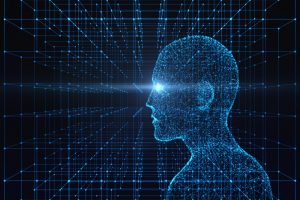
The common thread across all AI technologies is the ability to impart human-like decision-making capabilities into applications and systems.
Artificial intelligence (AI) refers to the simulation of human intelligence in systems programmed to think like humans and mimic their actions. AI includes a broad range of technologies, including cognitive computing, deep learning, expert systems, machine learning, natural language processing, and IBM Watson.
The common thread across these areas, and all of AI, for that matter, is the ability to impart human-like decision-making capabilities into applications and systems. Experts predict AI will be rapidly adopted because they believe it will be a disruptive technology across many industries.
There already are many examples of the impact AI has in a variety of fields, including:
- In agriculture, AI is helping farmers more accurately predict corn yield rates and enabling farmers to grow about 30% more tomatoes using 20% less fertilizer.
- In healthcare, AI brings benefits to both patients and healthcare providers. Examples include predictive models that predict Sepsis in pediatric patients and real-time audio signal analysis to deliver clearer sounds to people using hearing devices.
- In retail, AI is being applied in new ways across the entire retail product lifecycle – from design to purchase. Retailers and online merchants are investing in AI to improve the customer experience, aiming to do things like using AI insights to enhance recommendations based on real-time information while the customer is on a call, in a store, or visiting a website. Technology providers, seeing the demand for AI, are embedding it into their customer relationship management (CRM) systems used by retailers.
- In manufacturing, AI helps with predictive maintenance to keep production lines running, thus reducing downtime. And it is used for forecasting to optimize spare parts inventory, taking the just-in-time philosophy to maintenance operations.
- In financial services, AI is changing all aspects of operations. Robotic process automation (RPA) speeds routine tasks, allowing institutions to deliver better service while optimizing the use of staff resources. Real-time fraud detection and prevention is another major area for AI in financial services. Meeting ever-more-challenging global regulatory requirements is yet another area where AI plays a role.
Sub-divisions of the AI Market
AI is a very broad field with many subcategories. Each is aimed at particular application areas and uses specific technologies for those application areas. They include
Cognitive computing
Cognitive computing is the use of computerized models to simulate the human thought process in complex situations where the answers may be ambiguous and uncertain. It mimics how humans learn, think, and adapt, enabling a wide range of real-time insights and actions.
For example, cognitive computing is being used to aid human resources with hiring decisions, help doctors make diagnoses and treatment decisions by using the data relating to a patient’s case to make suggestions with confidence levels assigned to them, and improve call center customer experience.
Cognitive computing enables such applications using several technologies, including:
- Cognitive intelligence: Cognitive intelligence is an area of AI that includes technology and tools that allow apps, websites, and bots to see, hear, speak, and understand user needs through natural language.
- Emotion detection: Emotion detection tries to gauge how people feel using capabilities, including facial expression analysis in images and video content, detection of voice inflections in speech and text, and more.
- Sentiment analysis: Sentiment analysis uses natural language processing, text analysis, and computational linguistics to identify, extract, quantify, and study affective states and subjective information in text streams, voice messages, images, and videos.
Deep learning
Deep learning is a subset of machine learning in artificial intelligence (AI) that has networks capable of learning unsupervised from unstructured or unlabeled data. Deep learning systems not only think, but keep learning and self-directing as new data flows in.
Deep learning can play a role in a range of real-time, interactive applications, including speech recognition, visual recognition, and machine translation. It accomplishes this using several techniques and technologies including:
- Neural networks: Neural networks are algorithms and computational systems that mimic the human brain to interpret data and recognize patterns.
- Fuzzy logic: Fuzzy logic uses mathematical methods to try to approximate human reasoning to make decisions on raw and ambiguous data.
- Image recognition: Image recognition uses algorithms to identify objects (people, buildings, furniture, and more) in photos and video streams.
- Inference engine: An inference engine makes decisions using facts and rules in an expert system’s knowledge base or deep learning AI algorithm derived from a deep learning AI system.
Expert systems
An expert system that uses artificial intelligence techniques and databases of expert knowledge to offer advice or make decisions. In particular, expert systems emulate the decision-making ability of a human expert. Expert systems are designed to solve complex problems by reasoning through bodies of knowledge, represented mainly as if-then rules rather than through conventional procedural code.
A key attribute of expert systems is that they automate many tasks and work interactively with external information (e.g., a text message, an event log, a verbal question or answer, and more). Application areas for expert systems include use as:
- Intelligent agents: An intelligent agent is an autonomous entity that uses data from sensors, text streams, voice commands, and other sources to take action.
- Personal assistants: Personal assistant applications increase a user’s productivity by automating common tasks such as setting an alarm, scheduling a meeting, sending an email or text, searching for answers to questions, and more.
- Chatbots: Chatbots are software, applications, or algorithms that conduct a verbal or text-based conversation with a human using speech recognition, text-to-speech, natural language processing, and more. In some cases, chatbots outperform their human counterparts.
- AIOps/ITOps: Artificial intelligence for IT operations (AIOps) uses cognitive computing, including AI and machine learning, to automate and improve IT operations.
Machine learning
Machine learning is an application of artificial intelligence that provides systems the ability to automatically learn and improve from experience without being explicitly programmed. Machine learning uses structured data that has a single, direct input for each field used. In general, machine learning makes use of clean data, that is easy to work with, and for which there are no nuances to it. (In contrast, deep learning uses unstructured data.)
Machine learning is best when there are massive volumes of structured data that would take years for a human operator to process. It can efficiently classify information, predicting outcomes based on previous behavior and performance, and organizing information together based on key variables. General applications areas include:
- Machine vision: Machine vision uses automated AI- or machine learning-based image analysis and image detection to give systems human-like image detection capabilities in a wide range of applications, including robot guidance, automated process control, automatic inspection, and autonomous vehicles.
- Pattern matching: Pattern matching algorithms check for the presence of a given sequence of data in a larger dataset. It is used in a wide range of applications, including data searches, information retrieval, virus scanning, DNA sequence analysis, data mining, network security, and more.
Natural language processing
Natural language processing (NLP) makes use of linguistics and artificial intelligence to improve interactions between computers and humans. In many applications, NLP is used to help solve a problem, answer a question, or direct a person to an appropriate resource based on the spoken word.
To achieve such results, NLP-bases systems make use of some core technologies and deliver essential capabilities, including:
- Text-to-speech: Text-to-speech systems use software to artificially produce human speech. Such systems and algorithms create an audio output in the form of a spoken voice, which can be used in applications or hardware products.
- Speech-to-text (text generation): Speech-to-text algorithms use natural language processing and machine learning to turn the spoken word from in-person exchanges, video clips, or audio streams into text for use by other applications.
- Translation: Speech translation instantly translates conversational spoken phrases and audio streams from one language to another. Systems and applications that perform speech translation make use of AI, natural language processing, and other technologies.
IBM Watson
IBM Watson is an artificial intelligence platform that helps businesses predict and shape future outcomes, automate complex processes, and optimize employee productivity. It is widely known from its first use case as a question and answer computer system used in a series of matches against humans on the TV show Jeopardy!
Today, IBM Watson technology delivers a competitive advantage to businesses by using AI to unlock the value of data in new, profound ways, giving every member of a business the power of AI. IBM Watson consists of a suite of pre-built applications and tools to give businesses insights to predict and shape outcomes and infuse intelligence into your workflows. Implementations of IBM Watson include:
- AI Everywhere: AI everywhere is the embedding of artificial intelligence into business processes to improve operations, enhance customer engagements, and speed the time to insight.
- Continuous intelligence: Continuous intelligence is a form of real-time analytics used to support decisions when actions must be taken in milliseconds to minutes. It enables smarter business decisions using streaming data and advanced analytics. It differs from traditional analysis in that it is always on for situational awareness, prescribes actions, and allows businesses to be proactive.





























